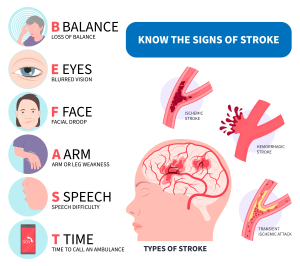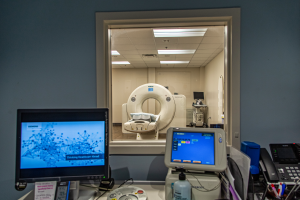Let’s talk about something that doesn’t get enough attention as it should–strokes. While common, strokes are extremely serious and often life-threatening if not treated immediately. In this article, we’re going to break down what causes strokes, how to recognize early signs, and what steps to take if an emergency arises. Here at Surepoint Emergency Center, we’re always ready to act fast when emergencies like these happen.
What is a Stroke, Really?
A stroke, also known as a cerebrovascular accident (CVA), is a medical emergency that occurs when blood flow to the brain is blocked or interrupted, causing brain cells to die within minutes. This potentially leads to other neurological deficits that can be temporary or permanent. Different types of strokes present distinct symptoms and outcomes, including:
- Ischemic (87%): blocked blood clot in a brain artery, cutting off blood flow.
- Hemorrhagic (13%): A burst blood vessel in the brain, causing bleeding into the brain tissue.
 No matter what type of stroke occurs, timing is everything. Recognizing the early warning signs can be the difference between a full recovery, lasting damage, or even saving a life. One of the best tools for spotting stroke symptoms is the B.E.F.A.S.T. acronym:
No matter what type of stroke occurs, timing is everything. Recognizing the early warning signs can be the difference between a full recovery, lasting damage, or even saving a life. One of the best tools for spotting stroke symptoms is the B.E.F.A.S.T. acronym:
- Balance: Sudden loss of balance or coordination
- Eyes: Sudden trouble seeing in one or both eyes
- Face: Loss of strength in face muscles, face drooping
- Arms: Weakness or numbness, specifically on one side
- Speech: slurred or unrecognizable speech
- Time/Terrible Headache: Call 911 or head to the ER immediately if an ambulance is not available
Who’s Most At-Risk?
According to the Centers for Disease Control and Prevention, medical conditions, lifestyle choices, and genetics are considered major risk factors for strokes. Certain medical conditions include:
- High blood pressure: the leading cause of strokes
- Abuse of Alcohol
- High cholesterol: extra cholesterol can build up in the arteries
- Heart disease: plaque builds up in the arteries
- Diabetes: sugars can build up in your bloodstream, potentially blocking blood flow
- Obesity: research links this chronic illness to high lipoprotein (bad cholesterol) and triglyceride levels
- Sickle cell disease: deformed (sickle) red blood cells block the bloodstream
Research shows how lifestyle choices such as your diet, physical activity levels, tobacco use, and alcohol consumption can significantly impact your risk of having a stroke. While age is a major risk factor, experts have found that younger people are having more strokes because of obesity, high blood pressure, diabetes, and energy drink addiction.
Prevention Tips That Can Make a Real Difference
Strokes can be prevented with the right lifestyle habits and a little consistency. It might sound simple, but incorporating a heart-healthy diet (find out about what foods positively affect your heart here), consistent exercise, blood pressure monitoring, and stress management can play a huge part in reducing your risk of strokes. These small steps add up–what you do today could save your life tomorrow.

How Surepoint Emergency Center Can Help
If you or a loved one experiences stroke symptoms, you can count on Surepoint to be there for you in your time of need. At any of our 13 convenient locations across North and West Texas, you can expect:
- 24/7 emergency care
- Raid response and diagnostics
- On-site imaging (CT scans) for stroke identification
- Shorter wait times than traditional hospitals
This kind of medical condition requires a timely response to ensure the survival of the affected individual. At Surepoint Emergency Center, you can expect fast, expert care at all times, because minutes matter!
Surepoint Emergency Center is a modern emergency medical facility open 24/7. As an alternative to the traditional hospital ER experience, we offer convenience and minimal wait time, along with highly-trained emergency medical staff and state-of-the-art equipment.
Our top priority is bringing high-quality emergency care, quickly and easily to your family. We are committed to making patients feel better faster in a comforting and compassionate environment.
Expert convenient care in your neighborhood.



References
American Heart Association. (2023). May Is American Stroke Month. https://www.heart.org/en/professional/quality-improvement/get-with-the-guidelines/get-with-the-guidelines-stroke/american-stroke-month
Centers for Disease Control and Prevention. (2024, May 15). Risk factors for stroke. https://www.cdc.gov/stroke/risk-factors/index.html
Geiger, D. (2024, November 4). Know the signs of stroke. Duke Health. https://www.dukehealth.org/blog/know-signs-of-stroke-be-fast
Ma, H. (2006). Cholesterol and Human Health. Nature and Science, 2(4). http://www.jofamericanscience.org/journals/am-sci/0201/05-mahongbao-0105.pdf
What is a stroke? | NHLBI, NIH. (2023, May 26). NHLBI, NIH. https://www.nhlbi.nih.gov/health/stroke



